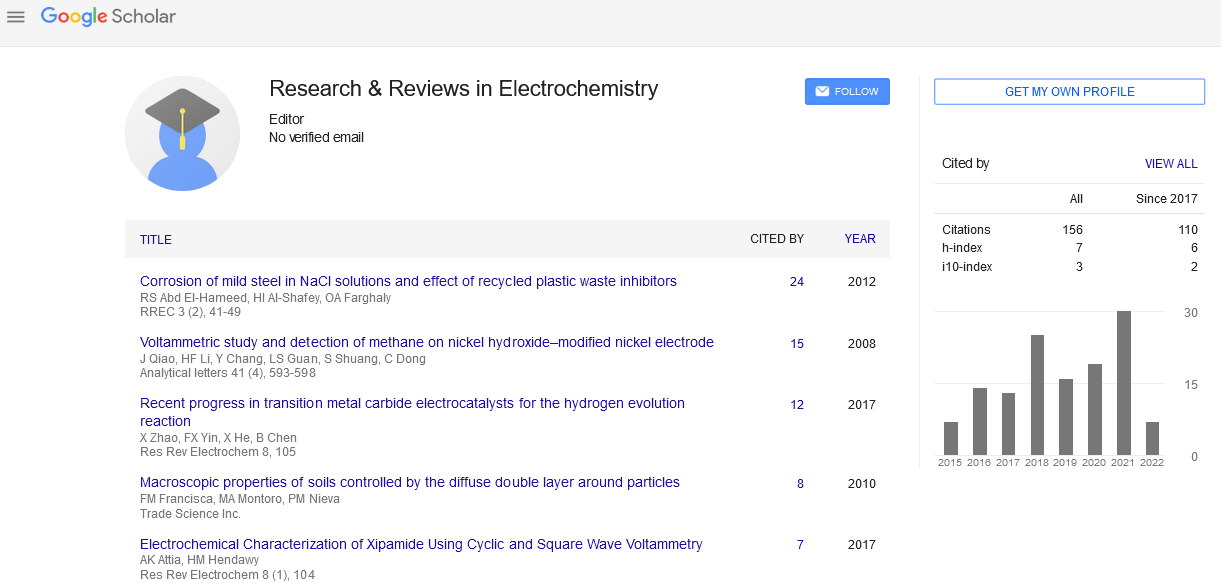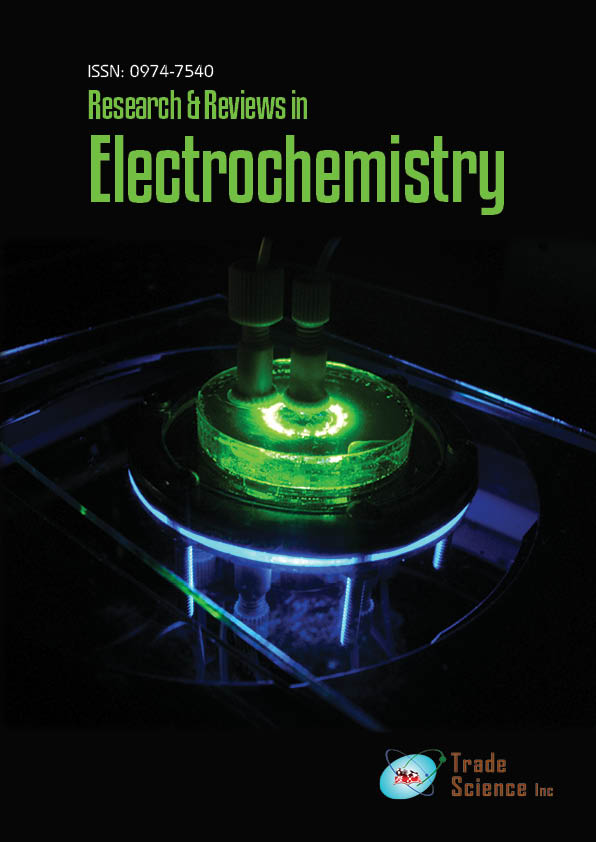Review
, Volume: 8( 1)Current Development of Selected Biosensors
- *Correspondence:
- Ahmad Suleiman , Department of Chemistry, Southern University, Baton Rouge, LA, USA, Tel: (225) 771-3715; E-mail: aasuleiman@aol.com
Received: January 06, 2017; Accepted: February 11, 2017; Published: February 14, 2017
Citation: Suleiman A. Current Development of Selected Biosensors. Res Rev Electrochem. 2017;8(1):102.
Abstract
Keywords
Biosensors; E. coli; Atrazine; Cortisol; Cocaine
Introduction
Piezoelectric sensors
The use of piezoelectric devices as sensors was realized after Sauerbrey [1] described the relationship between the resonant frequency of an oscillating crystal and the mass deposited on its electrodes:
ΔF = -2.3 × 106 F2 ΔM/A
Where ΔF is the change in frequency, F is the resonant frequency of the crystal, ΔM is the mass deposited and A is the area coated. The early applications were limited to the use of organic and inorganic coatings for the detection and determination of various pollutants [2-4]. The use of an antigen as coating was first demonstrated in 1972 [5]. Then there were several scattered reports on using biomolecules as coatings. Subsequent technological advances including immobilization protocols, amplification schemes and improvements in circuit design led to a rapidly rising interest in the development of such sensors. A wide range of methodologies describing the detection and determination of a vast number of analytes has been reported.
Amperometric biosensors
An amperometric sensor is based on the detection and determination of an electroactive species involved in the recognition process. In the early stages, biosensors were mainly enzyme electrodes, developed exclusively for the clinical analysis of glucose. The first amperometric enzyme electrode was reported by Clark [6] and was based on the following enzymatic reaction:
β - D-glucose + O2 –GOD→ H2O2 + D-gluconic acid
The electrode monitors either the oxygen consumption or the hydrogen peroxide production. Other enzyme electrodes involving mediators have been also developed. In general, hydrogen peroxide generating oxidase and NAD+ dependent dehydrogenase are good candidates for the development of amperometric enzyme electrodes. In addition, electrochemical immunoassays that exploit the selectivity of antibodies and amplification of enzymes have attracted special attention. Sensors utilizing receptors and natural products (i.e., plants, tissues and whole cells) have been also reported [7]. Recently, most of the research effort has been focused on developing miniaturized sensors, lab-on-a-chip technologies and multiple analyte-sensing capabilities, using arrays.
Fiber optic sensors
Fiber optic spectroscopy has attracted considerable attention especially since the new technology offers the possibility of remote sensing when working with highly toxic pathogens. Optical sensors were originally designed for blood gas measurements [i.e., O2, CO2 and pH], however, optical biosensors have been under intensive investigation. The first fluorescence-based fiber optic biosensor was described by Shultz and Sims [8].
In addition, chemiluminescence and bioluminescence-based sensors were also reported [9,10]. Early reports described immunosensors for benzo[a]pyrene [11,12], parathion [13], cocaine [14] and aflatoxin B1 [15]. Generally, the common approach is to immobilize the antibody or the antigen at the distal tip of the fiber followed by exposure to labeled or unlabeled antigen or antibody. After washing, the change in luminescence intensity that is proportional to the concentration of the antigen in the solution is measured.
In addition to a plethora of manuscripts, there are several books and reviews that have been published covering the respective topic. The reader is referred arbitrary to a couple of books [16,17] and reviews [18,19].
Results and Discussion
Detection of E. coli
Three different methodologies were evaluated utilizing antibodies in conjunction with piezoelectric, electrochemical and fiber optic sensors.
The piezoelectric sensor involves immobilization of the antibody on the gold electrodes of the quartz crystal. The gold surface of the crystal was first activated by washing with 1 M NaOH, followed by 1 M HCl, then with distilled water. The next step involved immobilization of protein A followed by immobilization of the antibody via cross-linking with glutaraldehyde. The “dip and dry” method of measurement was initially evaluated, then abandoned due to lack of reproducibility. Two oscillator circuits capable of oscillating AT cut piezoelectric crystal totally immersed in solution were built and tested. The effects of temperature and viscosity and other parameters affecting the response were evaluated. Results from the respective experiments indicated that it was feasible to detect down to 700 cells/mL of E. coli. Scanning electron microscope images revealed that numerous E. coli [fixed with 2% glutaraldehyde] were attached to the gold electrode if under-liquid detection protocol is followed. However, air-dried crystals showed no signs of E. coli attachment.
For the electrochemical sensor, the enzyme horseradish peroxides and the antibody were co-immobilized on an immobilon AV affinity membrane mounted over the tip of an oxygen electrode jacket. In the presence of bacteria, the activity of the enzyme decreased due to the formation of an immuno-complex. The changes in current response to peroxide are monitored and related to the concentration of bacteria. The optimum conditions with respect to peroxide concentration, pH of phosphate buffer, amount of E. coli antibody and peroxidase were 4 × 10-3 M, pH = 7.5, 40 units and 40 μl, respectively. As low as 5 cells/mL of bacteria were detected and the calibration curve was linear in the concentration range of 10 cells/mL to 65 cells/mL.
In another approach, an antibody-FITC conjugate is immobilized on a micro porous membrane, which is mounted over the tip of an optical fiber bundle. The formation of an antigen/antibody complex shields the fluorescent label, resulting in a decrease in fluorescence intensity that is proportional to antigen concentration. The calibration curve was linear in the concentration range of 10 cells/mL to 150 cells/mL.
Detection of cortisol and cocaine
Two amperometric immuno-sensors were developed for cortisol, an indicator of the adrenal and for cocaine. The sensor was constructed by co-immobilizing horseradish peroxidase [POD] and the respective antibody on a chemically activated affinity membrane that is mounted over the tip of an oxygen electrode. POD catalyzes the following reaction:
H2O2–POD→ H2O + ½O2
The current response to H2O2 decreases in the presence of the respective analyte since the activity of the enzyme decreases due to the association of the analyte to the immobilized antibody. The decrease in enzyme activity is proportional to the analyte concentration. The optimum conditions for the two sensors will be discussed. The calibration curve for each was linear in the concentration range of 1 × 10-7 M to 1 × 10-5 M.
Two fiber optic sensors were developed for both cortisol and cocaine. The respective sensor is a regenerable fluorescence based fiber optic immunosensor utilizing immobilized fluorescein isothiocynate/anti (cortisol or cocaine) conjugate onto a hydrophilic micro porous membrane mounted over a Teflon tube that fits tightly around the common end of the fiber bundle. The principle of the sensor is based on the formation of an antigen/antibody complex that shields the fluorescent label causing a decrease in intensity proportional to the concentration of the analyte. Typical calibration curves showed that the plots of both the fluorescence peak intensities and peak areas vs. analyte concentrations were linear in the range of 8 × 10-9 M to 1 × 10-7 M.
Detection of atrazine
An atrazine immunoassay was developed utilizing anti-atrazine antibody in conjunction with a fiber optic fluorescence sensor. Three protocols were tested including:
1. The unlabeled antibody was immobilized on an activated membrane that was attached to a cylindrical tip on the top of the common end of a fiber bundle. The membrane was exposed to a blocking agent, and then atrazine followed by a labeled antibody conjugate.
2. Atrazine was immobilized on the membrane, and the tip was exposed to the conjugate, blocking agent, then atrazine.
3. The conjugate was immobilized on the membrane, and the tip was exposed to the blocking agent followed by atrazine.
4. The variation in fluorescence intensity was measured and related to the concentration of atrazine. Procedures for preparation for the fluorescent antibody conjugate and other parameters such as amount of antibody, removal of unbound FITC, leachate and incubation time were optimized. The calibration curve was linear in the concentration range of 1 × 10-7 M to 1 × 10-5 M.
Conclusion and Future Trends
The use of biosensors is becoming a viable alternative to conventional analysis. Improvements in immobilization techniques and sensor design will enhance the versatility of the sensors. Furthermore, miniaturization, the rapidly developing nanotechnologies and neural networking techniques are poised to contribute significantly to future advancements in sensor technologies. It is expected that sensors will play a major role in the diagnostic and environmental analysis. Handheld devices with multi-analysis capabilities will emerge as valuable tools in all major industries.
References
- Sauerbrey G. Angew Z, Phys.1959;155:206.
- King WH. Piezoelectric sorption detector. Anal Chem. 1964;36(9):1735.
- McCallum JJ. Prediction of gas sensor response using basic molecular parameters. Analyst.1989;114:1173.
- Suleiman AA, Guilbault GG. Piezoelectric crystal detectors for environmental pollutants.Environmental Oriented Electrochemistry. 1994;59:273-303.
- Shons A, Dorman F, Najarian J. An immunospecific microbalance. J Biomed Mater Res. 1972;6(6):565-70.
- Clark LC, Lyons C. Biosensors: Recent trends.Ann NY Acad Sci.1962;29:102.
- Rechnitz G, Ho M. Optical algal biosensor using alkaline phosphatase fordetermination of heavy metals. J Biotechnol. 1990;15;201.
- Schultz JS, Sims G. First clinical evaluation of a new long-term subconjunctival glucose sensor. Biotechnol. Bioeng. Symp. 1979;9:65.
- Freeman TM, Seitz WR. Chemiluminescent determination of luminol and hydrogen peroxide using hematin immobilized in the bulk of a carbon paste electrode. Anal Chem. 1978;50:1242.
- Blum LJ, Gautier SM, Coulet PR. Luminescence fiber optic biosensor. Anal Lett. 1988;21:717–26.
- Tromberg BJ, Sepaniak MJ, Vo-Dinh J, et al. Fluorescence monitoring of a benzo [a] pyrene metabolite using a regenerable immunochemical-based fiber-optic sensor. Anal Chem. 1987;59:1226.
- Vo-Dinh J, Tromberg BJ, Griffin GD, et al. Antibody-based fiberoptics biosensor for the carcinogen benzo(a)pyrene. Appl Spectrosc. 1987;41:135.
- Anis NA, Wright J, Rogers KR, et al. A fiber optic immunosensor for detecting patathion. Anala Lett. 1992;25:627.
- Devine PJ, Anis NA, Wright J, et al. A fiber-optic cocaine biosensor. Anal Biochem. 1995;227(1):216-224.
- Guilbault GG, Carter MR, Jacobs MB,et al. Paper 209, 213 ACS National Meeting, San Francisco, CA, April, 13-17 (1997).
- Banica FG. Chemical sensors and biosensors: Fundamentals and applications: 1st ed. UK: John Wiley; 2012.
- Taylor RF, Schultz JS. Handbook of chemical and biological sensors. UK: IOP Publishing Ltd;1996.
- Turner APF. Communication—Accessing stability of oxidase-based biosensors via stabilizing the advanced H2O2transducer. Chem Soc Rev. 2013;42:3184.
- www.intechopen.com

